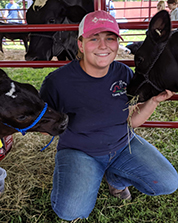
Cattle can’t ever calve when it’s sunny and 75°F. No, they always must calve during blistering hot days, thunderstorms, winter storms, negative temperatures, or during a combination of the aforementioned. Either way, it’s never in ideal temperatures.
A few weeks ago in Virginia, we received our third winter storm of the year. For all my Northern and Western friends, you are probably laughing at the fact it is just our “third.” However, we usually get one storm, maybe two. Three is a bit excessive and at this point, I don’t ever want to see this white, slushy, pain in the rear stuff again. With the wind blowing, snow falling on us, and temperatures well below freezing, we, of course, had a heifer calve in two weeks early in one of the worst locations on our farm.
We keep our bred heifers in a maternity pasture about a mile or so from the farm. The pasture is large enough to house 20 heifers comfortably throughout the year. We usually have a group there that’ll calve in between March and June and another in August through October. The pasture provides plenty of grass, water, and space for the cattle to graze and relax until calving. We keep strict records on calving dates to be able to separate the cattle if the weather is projected to be a challenge. Our system works until it doesn’t.
Last week we experienced flooding across the state. This week it’s snowing, cold and miserable once again. During the worst part of the snowstorm, one of our heifers calved two weeks early in the middle of a flood plain. Not only was the snow a challenge, the partially frozen water and mud proved to be a challenge. Our saving grace was that we had purchased a ball hitch to go on a three-point hitch. With that implement, we were able to hook the trailer to our four-wheel drive tractor to rescue the cow and calf.
After an hour of running up and down the slick hills of the cow pasture, pulling muscles I didn’t know existed, wiping out whenever the cow tried to turn back, and questioning all my life’s choices, we finally had the heifer and calf on the trailer and headed to the farm. When we arrived, the heifer went into a cow group to get some much-needed rest, feed, and water. The calf went into the “hot box” (a box made of plywood full of straw and a heat lamp), to thaw out and get warm. It was a completely exhausting and frustrating day to find a heifer with a baby, but it was rewarding. After a long day in the storm, it was more than rewarding to see the calf eat and stand and the heifer milk like a dream. Not every day can be sunny and 75°F, and cows certainly do not care when they calve, but at the end of the day if they are safe and sound, that’s all that matters.

The author is a sixth-generation farmer and fifth-generation dairy producer in southwest Virginia, where she and her family own and operate a 145-head Holstein dairy. Courtney is involved in agriculture organizations throughout her community and is a graduate of Virginia Tech.